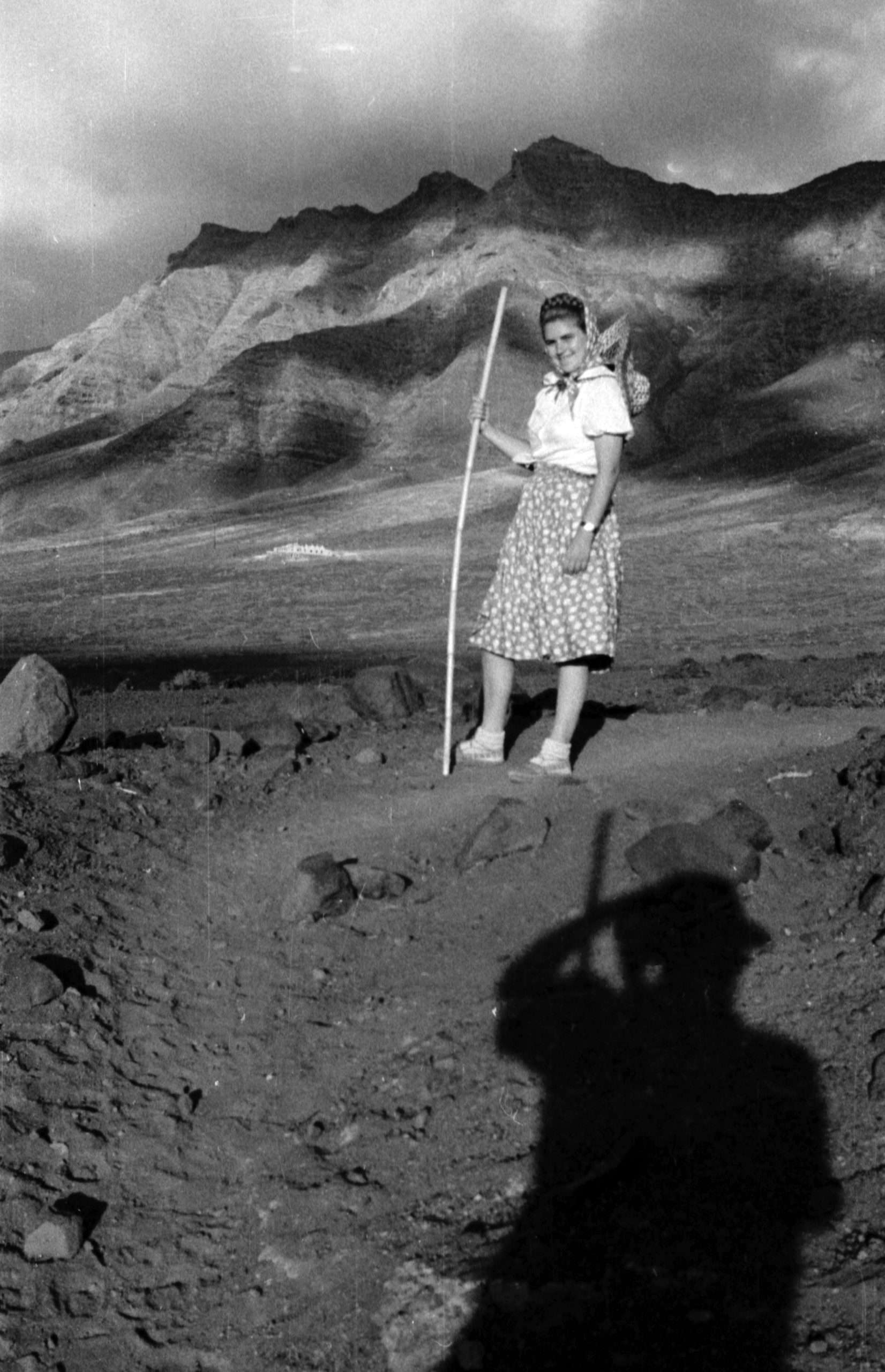Between 1946 and 1955, the Winter House was built as a dream that challenged time. In front of the teacher D. Juan Concepción Villalba as a witness, Gustavo Winter sought inspiration in the minds of Mr. Miguel García and D. Eugenio Ibáñez. However, the construction was challenged by the shortage of iron and cement. The foundations rose in January 1947, finding obstacles that delayed them. While the plans were traced, Isabel Althaus and Gustavo Winter moved to Fuerteventura in 1948. During the following years, the house advanced slowly, eclipsed by other priorities. However, Gustavo Winter's determination remained firm, and finally, in 1955, the works ended, thus crowning this iconic villa. A story chapter eternally woven on stone walls, with the Winter house as its epitome.
1946
October 1946: arrival of Maestro Mr. Juan Concepción Villalba to Jandía
He was the contractor in charge of the construction of the house. He had already done some previous work in Jandía. It was he, who started the foundation work of the house in 1942. On many of the letters, he’s referred to as “Maestro Villalba”.The Background section includes the quotations he submitted in July 1946 to complete the foundation work and build the house, also for several stretches of road and a pier in Morro Jable.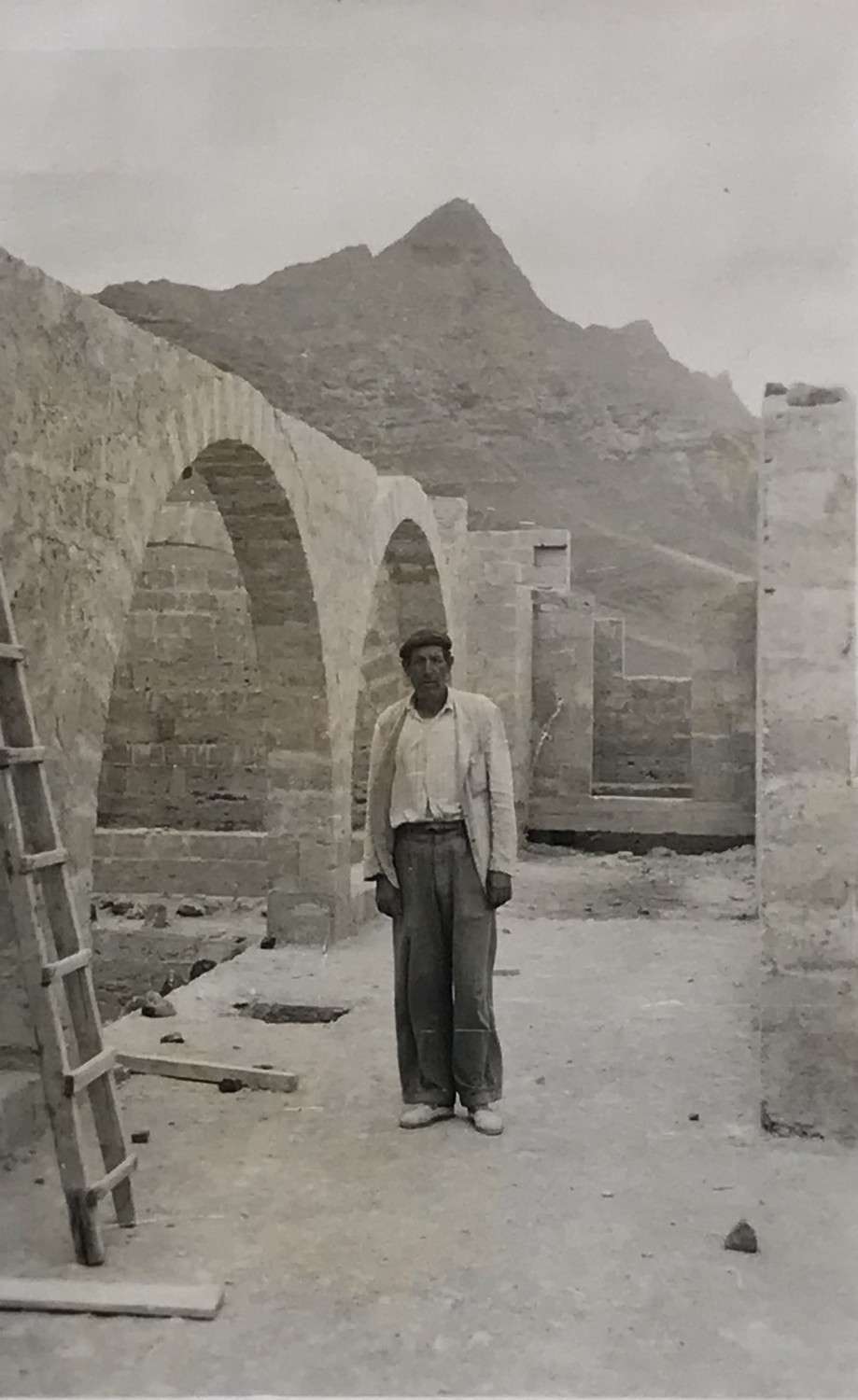 Maestro Juan Concepcion Villalba - 18 julio 1947
Maestro Juan Concepcion Villalba - 18 julio 1947
He arrived to Jandía from Lanzarote, on Wednesday 2nd October 1946. He immediately moved to Cofete to get the work underway. This document includes the letters regarding his arrival to Morro Jable and then to Cofete:
Llegó a Jandía, procedente de Lanzarote, el miércoles 2 de octubre de 1946. Inmediatamente se trasladó a Cofete para iniciar los trabajos. En este se agrupan las cartas relativas a su llegada a Morro Jable y partida a Cofete:
-
At the end of letter number 3 from D. Guillermo Schrauth (GS) to D. Arturo Kamphoff (AK) dated 30/9/1946, the former wrote “Furthermore, I’m awaiting the arrival of the maestro who is to build the house.”
-
Letter number 4 from AK to GS, dated 03/10/1946, regarding Maestro Villalba, it says: “I have telegraphed Madrid about the arrival of said man.” There is a copy of the telegram sent by Mr. Arturo to Madrid (GW) attached.
-
Letter number 38 from GS to Mr. Manuel Girona (Gustav Winter, really), dated 05/10/1946, informing of the arrival of Maestro Villalba, and then to Cofete, and that he was given the drawings with some changes made to the initial project regarding the location of the rooms, kitchen and corridors on the basement. There is reference being made to a proposal in relation to the price of the foundations, the walls (97.50 ptas/m3) and the stonework of the facade (125 ptas/m2). Mr. Guillermo asked about the price for the use of the lime oven, renting the camels and a transportation cart to be pulled by donkeys.
October – November 1946. Gustav Winter asks Mr. Miguel García and Mr. Eugenio Ibáñez for ideas for the house
This document comes from a folder with a handwritten comment on it made by GW: “Mr. Miguel García”. Chronologically organising the content, first of all, we came across a copy of a letter in which Gustav Winter addresses him in October 1946 -who had been apparently been previously commissioned by GW to do a painting-, informing him of the fact that “the owner of the plot –Mr. Manuel Girona– is building a House for him and for me, whose foundation started in 1942, and whose completion is currently underway.” He attached a report (pages 2 to 6 of the document) about the project, and he asks him to send it on to a “good building engineer” to advise him when it comes to several issues and draft some blueprints. On page 4, the document mentions the stage the construction is at, at that time (21/10/1946): “The foundation is currently being built. The walls haven’t been built yet, so we’re still on time if the main beams need to be built differently to support the ceilings…”
A few days later (25/10/46, page 7 of the document) he also asks for a peninsula of Jandía relief to be done in plaster, based on a blueprint that Mr. Miguel García had previously done.
Page 8 includes an answer (it seems to be missing pages) from Mr. Eugenio Ibáñez (28/10/1946) –building engineer, according to a handwritten comment made by Isabel Althaus on a card that is stapled to it-. There are suggestions and requests for some issues to be clarified. There are comments written on paper by GUstav Winter (wood; roof framework; roof board width; ceiling board width).
On the answer given by Gustav Winter three weeks later (18/11/1946; pages 9 and 10 of the document), he informs about the stage the work is at and makes reference to his wish to “build a tower”, a place to have a view of the mountain and the sea. “We would highly appreciate any pencil-made suggestions regarding the tower mentioned.“
The tower has led to so many speculations! since it was wrongly believed that the house, and the “vigilance” tower had been built years prior, and was therefore standing during the 2nd World War.
Page 11 of the document is a letter from Gustav Winter, date 26/11/1946 (although it is not said who it is addressed to, it seems to be addressed to Mr. Miguel García), and it includes a report (pages 12 and 13) about the house: landscape, floor, foundation, roofs, etc., and he requests ideas and artistic solutions for the design of the tower, the lateral west wing facade where he would like to place a bell tower, the right slope of the roofs, decorative elements, etc.
There is no evidence of any replies given to these last two letters 18 and 26/11/1946.
Difficulties in finding iron and concrete
In those years, (1946 – 1948), materials were scarce and they were numbered. Maestro Villalba complained about the poor quality of the concrete received and the low supplies, with regard to the amount initially purchased, after being shipped and transferred to Cofete.
On this document, on the letter number 55, GS to Mr. Manuel Girona (GW) dated 07/11/1946, the suggestions made by Maestro Villalba are mentioned, with regard to the “location and construction of the basements and the shape that the ceiling of the underground gaps should have.”
On that same letter number 55, Mr. Guillermo says that Maestro Villalba accepts proposal number 2 made by Gustav Winter, regarding the completion of the foundation for the agreed price of 35,000 ptas. At the end, the difficulty when it comes to finding concrete is mentioned.
On letter number 9 from GS to AK, dated 2/12/1946, he asks for funds in order to pay Maestro Juan Concepción Villalba, as well as asking for concrete and iron. He informs about the fact that the Maestro thinks that it’s going to take him until 15/01/1947, the latest, to finish the foundation, depending on whether he can get the necessary concrete and iron on time.
At the beginning of the 2nd page of letter number 20, dated 09/12/1947 (page 5 of the document), Mr. Arturo writes about the difficulties when it comes to finding concrete in Gran Canaria so they can send it to Jandía.
On letter number 23 dated 13/12/1946, Mr. Arturo informs about having sent 10 sacks of concrete and funds to pay the Maestro on board engine-sailboat Pinito.
1947
There are 3 main events worth mentioning that year:
- The arrival of agricultural machinery to Jandía, as well as a large amount of goods and miscellaneous packages from Bilbao and Catalonia.
- The significant pace that the construction process of the house took from March to August that year.
- Gustav Winter’s visit toward the end of August, after not having been in Jandía in six years.
January 1947. Finishing the foundation
There were still important difficulties trying to find iron and concrete, which forced them to have to come up with solutions in order to manage to continue building: On page 3 of the document (page 2 of letter number 12 from GS to AK, dated 03/01/1947), Mr. Guillermo mentions that Maestro Villalba, when faced with difficulties finding iron and concrete, “suggests making (like the corridor and storage rooms 1 and 2) the ceilings and floors of the kitchen and annexes also arched shaped, so they would be as, or even sturdier than a floor made with reinforced concrete.” He asks for his suggestion to be taken to Madrid in order to figure out how to proceed. Finally, as we can see on the photos taken in May and July 1947, the ceilings of the basement corridors and storage rooms were arched shaped. Below, we shall talk in detail about the rooms on the basement floor.
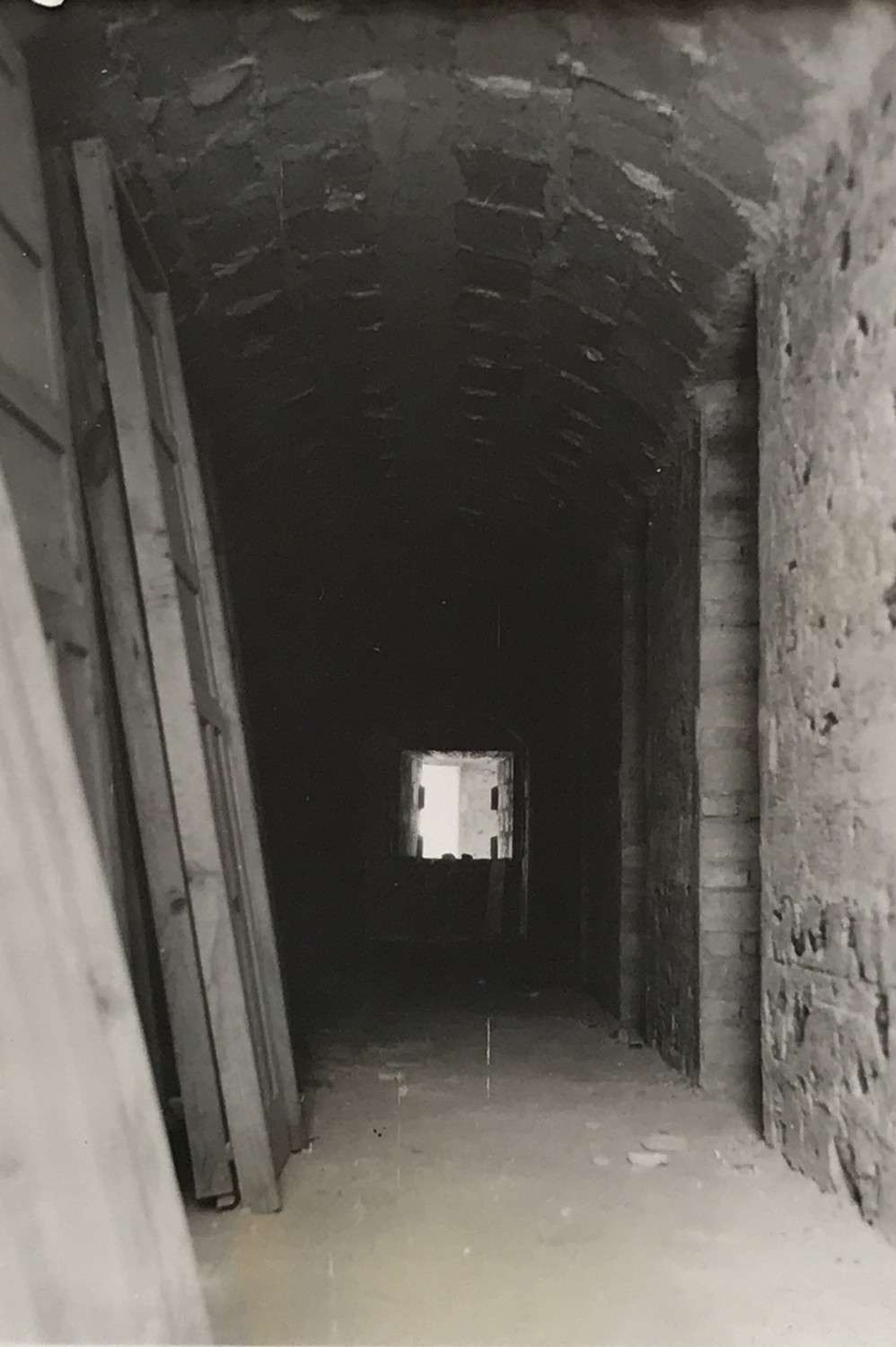 Vaulted ceilings as an alternative to iron and cement shortages - May 1947
Vaulted ceilings as an alternative to iron and cement shortages - May 1947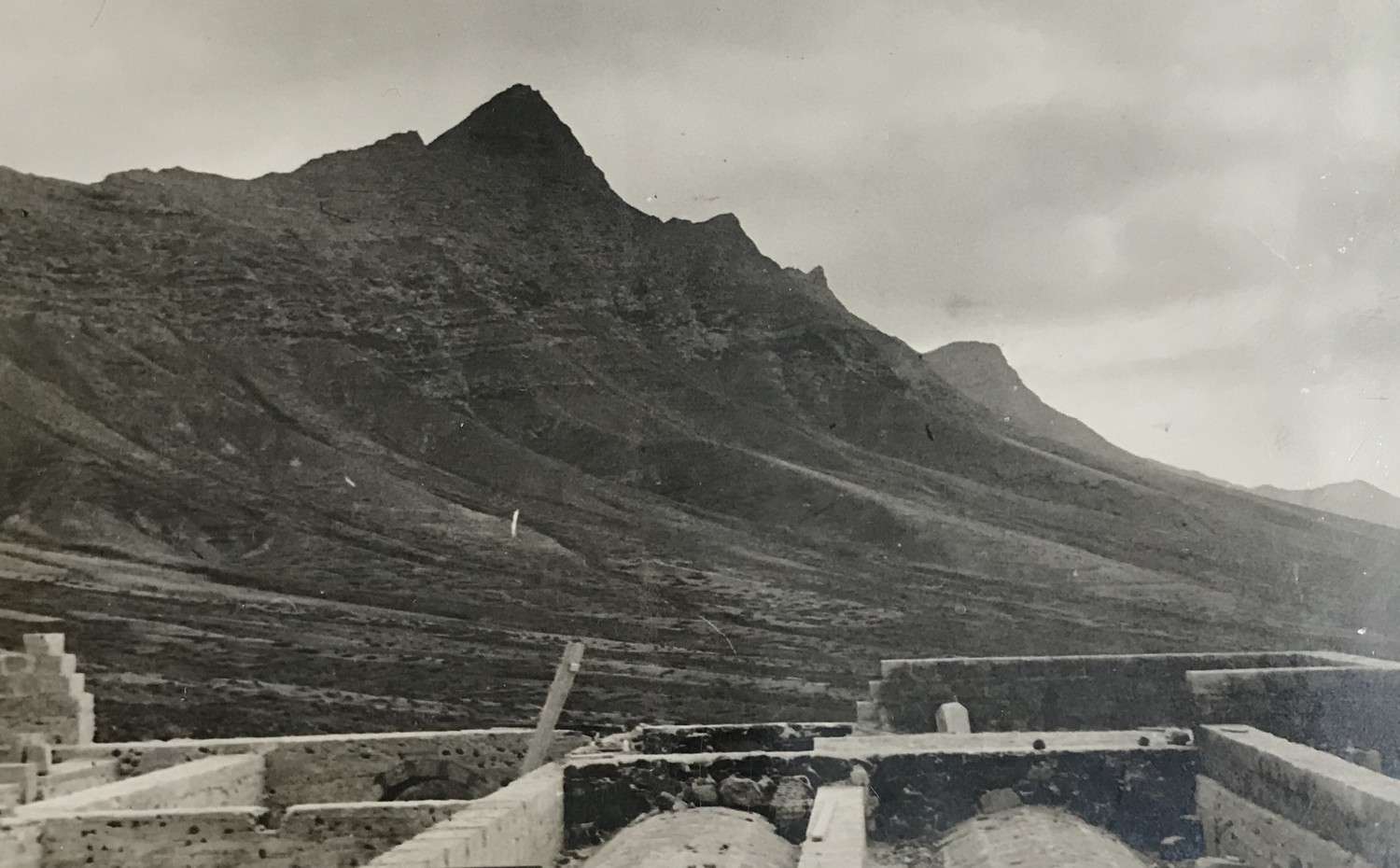 Vault-shaped basement ceilings - July 1947
Vault-shaped basement ceilings - July 1947On page 7 of the document, there is a transcription of a telegram from Gustav Winter from Madrid, demanding not to pay any funds to Maestro Villalba until building engineer Mr. Antonio Falcón doesn’t agree with the completion of the foundation and the swimming pool. On that document, there are handwritten notes: On page 6, one from AK: “Copy for Madrid” and, on page 7, a note made by Gustav Winter on the page margin: “10,000 (ptas) cash?”On page 9, it says that “Maestro Villalba has given me his word to finish the foundation work by 31st of the current month of January”, except for the ceiling of basements number III, because of the lack of the right iron to do so. Mr. Guillermo rushed Mr. Arturo so that the building engineer Mr. Falcón to move as soon as possible to Jandía in order to certify the completion of the foundation, so the agreed payment can be made to the Maestro.
March 1947. Speeding up the work pace
We can guess that it was around March, when the work on the main structure commenced.
On 01/03/1947, an agreement was signed with building engineer Mr. Antonio Falcón, who visited the site a week later and certified the completion of the foundation work, and explained to Maestro Villalba the steps to follow next, according to the drawings sent from Madrid.
On a previous letter, Gustav Winter had asked for fortnightly reports informing of the evolution of the construction work, and for Mr. Guillermo to periodically take photographs of the stage the work was at and send them on to Madrid. On letter number 16 dated 11/02/1947, Mr. Guillermo said: “I shall take the pictures in the next few days and I shall send them to be developed.” He suggests developing them himself in Jandía and explains, in Spanish and in German, the necessary steps to do so. At the end of the page, there is a handwritten note made by Gustav Winter: “develop them in Madrid”.
The photos of the construction process can be seen, for the March – August period of that year. Except for a series of pictures taken toward the end of May by Mr. Krozewski, the rest were all taken by Mr. Guillermo Schrauth. Letters number 40 from Arturo Kamphoff and 21 from GS, dated 15 and 18/03/1947, inform of the arrival of a batch of 3,100 hollow bricks from Tenerife, although they had ordered 10,000 and a 30% shortage of sacks of concrete received. Also, 24 boxes of lab material was received (to carry out water quality tests on the different fountains and wells).
Mr. Guillermo also mentions that Maestro Villalba has around 20 – 24 people, between temporary and permanent staff, working in the house, depending on the week. On this document (1947.6), there are several inventories, corresponding to the stage between the end of March and beginning of August 1947, stating a weekly list of the people who worked building the house, the days a week they worked, and how much they got paid. Those pages are signed by the contractor and the Maestro in charge of the work, Mr. Juan Concepción Villalba. We can see an increase in the number of workers during the months of May, June and July, due to a higher workload, including three maestros from Gran Canaria.
Although we cannot see it on those lists, there were also girls and women working on the construction, for instance bringing stones in baskets from the surrounding areas, to build and lift the wall surrounding the house.
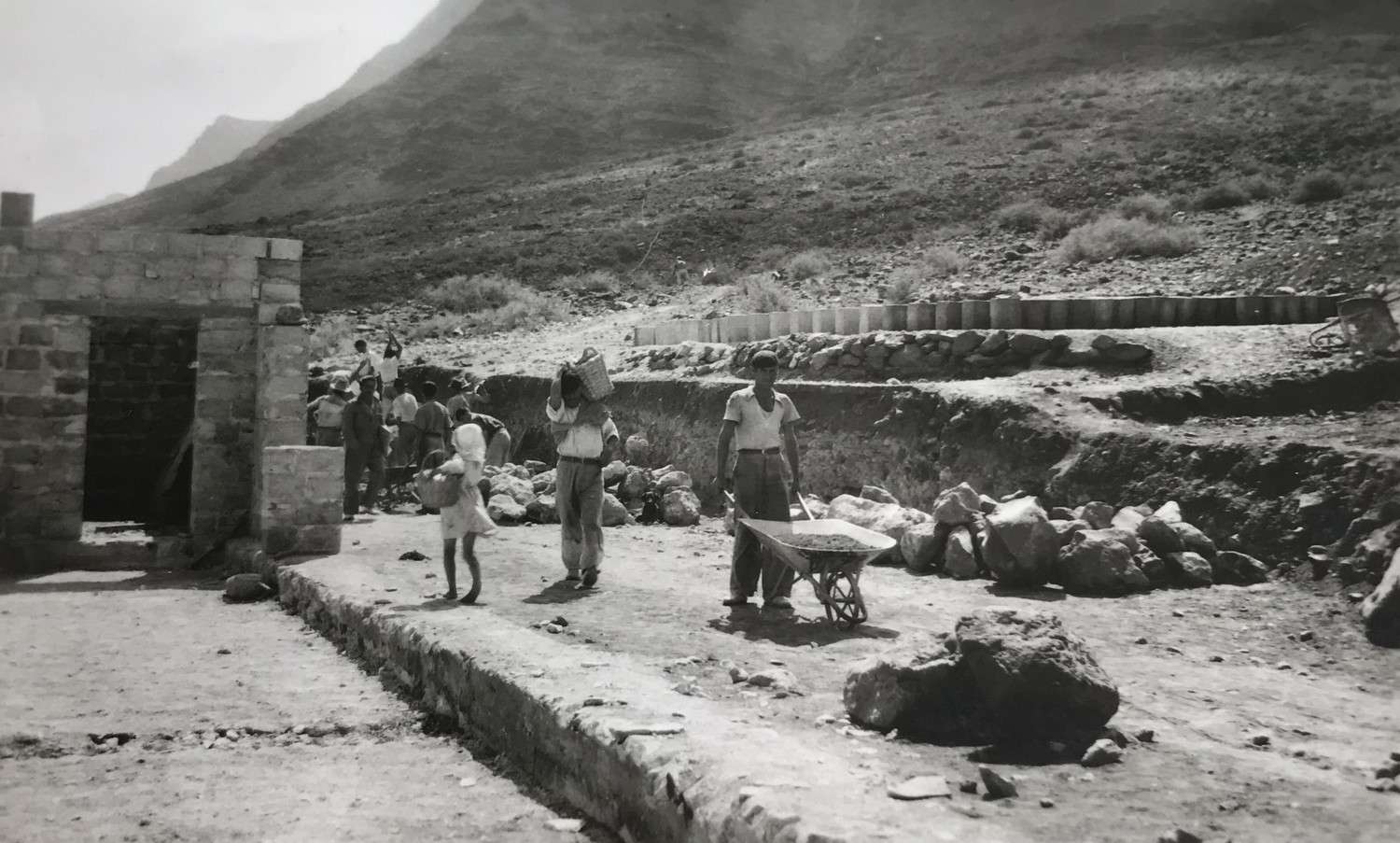 A little girl bringing food in a basket for her father, who is a construction worker in the house. June 12, 1947
A little girl bringing food in a basket for her father, who is a construction worker in the house. June 12, 1947
Letter number 41 from AK to GS, dated 19/03/1947, has instructions for building engineer Mr. Antonio Falcón to build a tennis court next to the house.
This document includes 3 letters. In Cofete there is a good working pace. Maestro Villalba needs more staff and there are three construction officers on the way from Gran Canaria, highly trusted by building engineer Mr. Antonio Falcón. Their names are included (Letter number 55 from AK to GS dated 07/05/1947). Mr. Arturo informs about sending 5,000 hollow bricks and 3,000 curved tiles on the Guanchinerfe, from Tenerife, as well as 3 hand tractors, a trailer for them and 10 sacks of concrete.
On letter number 30 de GS a AK, dated 09/05/1947, Mr. Guillermo confirms the arrival of the three building officers and photographer Mr. Krozewski, also from Gran Canaria, to make a photographic report, not only about the evolution of the work done on the house (already taken periodically by Mr. Guillermo Schrauth), but of the different locations of Dehesa de Jandía.
On letter number 56 from AK to GS, dated 12/05/47, in the section “House of Cofete”, there is reference made to fortnightly reports for building engineer Mr. Falcón, included in the corresponding reports sent to Madrid. Gregorio is mentioned. Mr. Gregorio Soto, another one of Gustav Winter’s trusted people, from the beginning of the lease, who also did the accounts in Jandía, among other things, and who often went to Gran Canaria. In 1954, he moved to Gran Tarajal, where he was originally from. Mr. Claudio Reyer, who back then lived in Gran Canaria, and since 1954 in Morro Jable, was hired to replace him.
On that letter, Mr. Arturo informs about the fact that the three building officers that went from Gran Canaria to work for a few months in the house of Cofete, that he shall process the social taxes, but that they will have to be “included on the list of insured staff in case of occupational hazard.”
Once they started receiving the photographs of the stages of the work and the fortnightly reports made by the building engineer Mr. Antonio Falcón, Gustav Winter began to draft drawings along with clarifying instructions regarding how to proceed with the construction work. He signed his short name at the bottom of many of those drawings, and wrote the date they were made alongside his characteristic number 7, that can also be seen on the cardboards with the pictures of the construction work. He would also write the date they were taken. The drawings that we are now sharing, truly correspond with the real construction work, as opposed to the “Reconstruction project of an agricultural house”, submitted at the Pájara Town Hall in 1949, which isn’t a true representation of the house. This can be verified by checking the instructions attached to the blueprints, as well as the content of the letters and photographic reports.
Isabel Althaus, Gustav Winter, their daughter Johanna and their son in law, Petre Munteanu visit Jandía
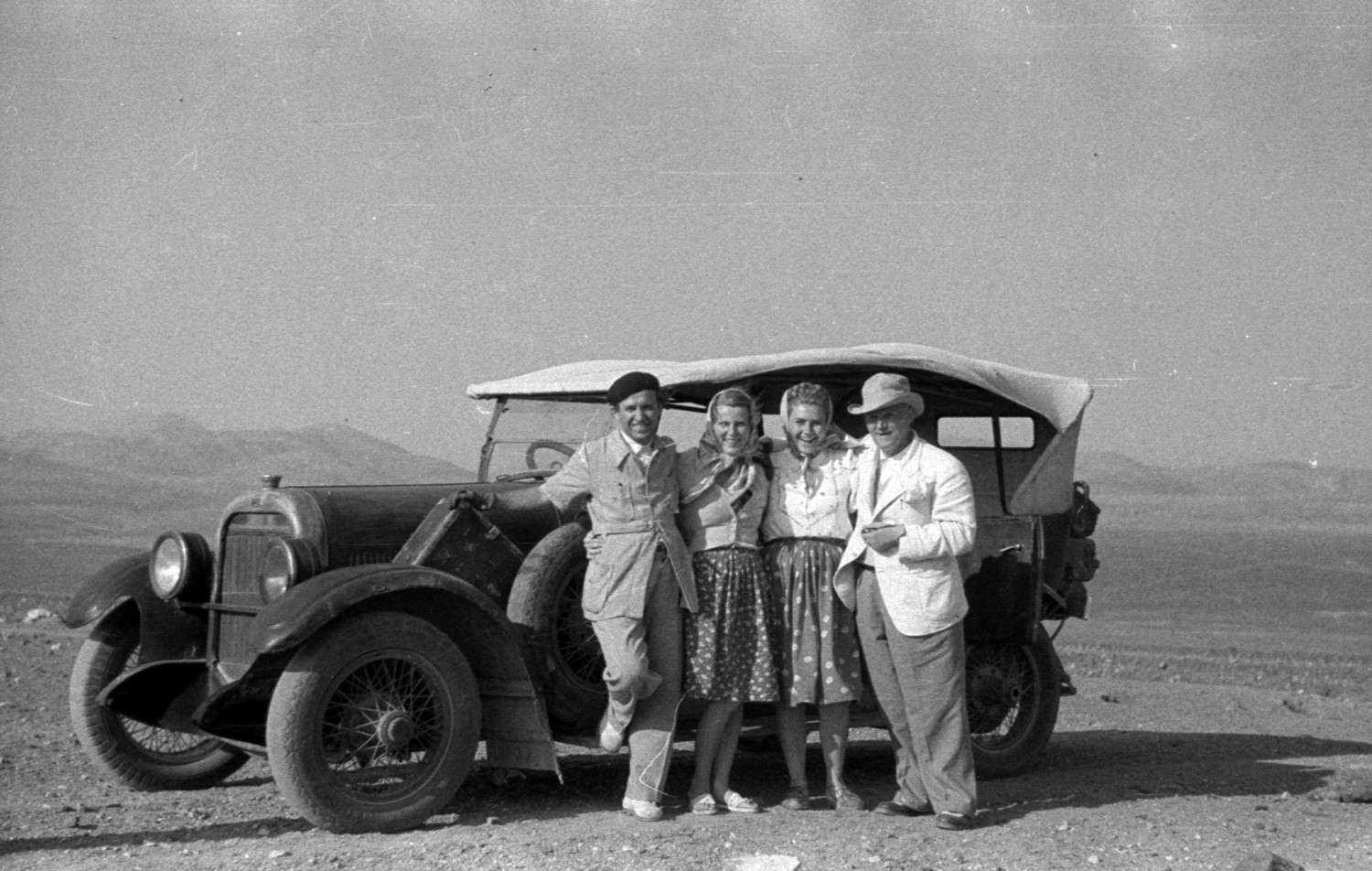 Matas Blancas - Agost 1947Gustav Winter hadn’t been in Fuerteventura since his previous visit in September and October 1941. Our mother, our sister Johanna and Petre* had never been Jandía. For months now, Gustav Winter had been talking about his definite move to the island (letters to AK, GS and Mr. Salvador Falero). By August, he could wait no longer and went over for five weeks. Besides being interested in different activities and concerns regarding the land (agriculture, water galleries, medianería, saltworks, roads, etc.), he needed to visit the building site, and see the worked in situ, as well as analyse the state of the work with the Maestro Villalba, figure out the necessary solutions and plan the work still to be done.
Matas Blancas - Agost 1947Gustav Winter hadn’t been in Fuerteventura since his previous visit in September and October 1941. Our mother, our sister Johanna and Petre* had never been Jandía. For months now, Gustav Winter had been talking about his definite move to the island (letters to AK, GS and Mr. Salvador Falero). By August, he could wait no longer and went over for five weeks. Besides being interested in different activities and concerns regarding the land (agriculture, water galleries, medianería, saltworks, roads, etc.), he needed to visit the building site, and see the worked in situ, as well as analyse the state of the work with the Maestro Villalba, figure out the necessary solutions and plan the work still to be done.
(*) Johanna and Petre Munteanu lived in Rome. Petre, was originally Rumanian, and he was renowned opera tenor. During his visit to Fuerteventura, he went to Las Palmas de Gran Canaria for a few days since he had been hired to sing two performances in the Teatro Pérez Galdós (courtesy of José Luis Abaroa), on 05 and 11/09/1947. Some people from Morro Jable remember having heard him rehearse.
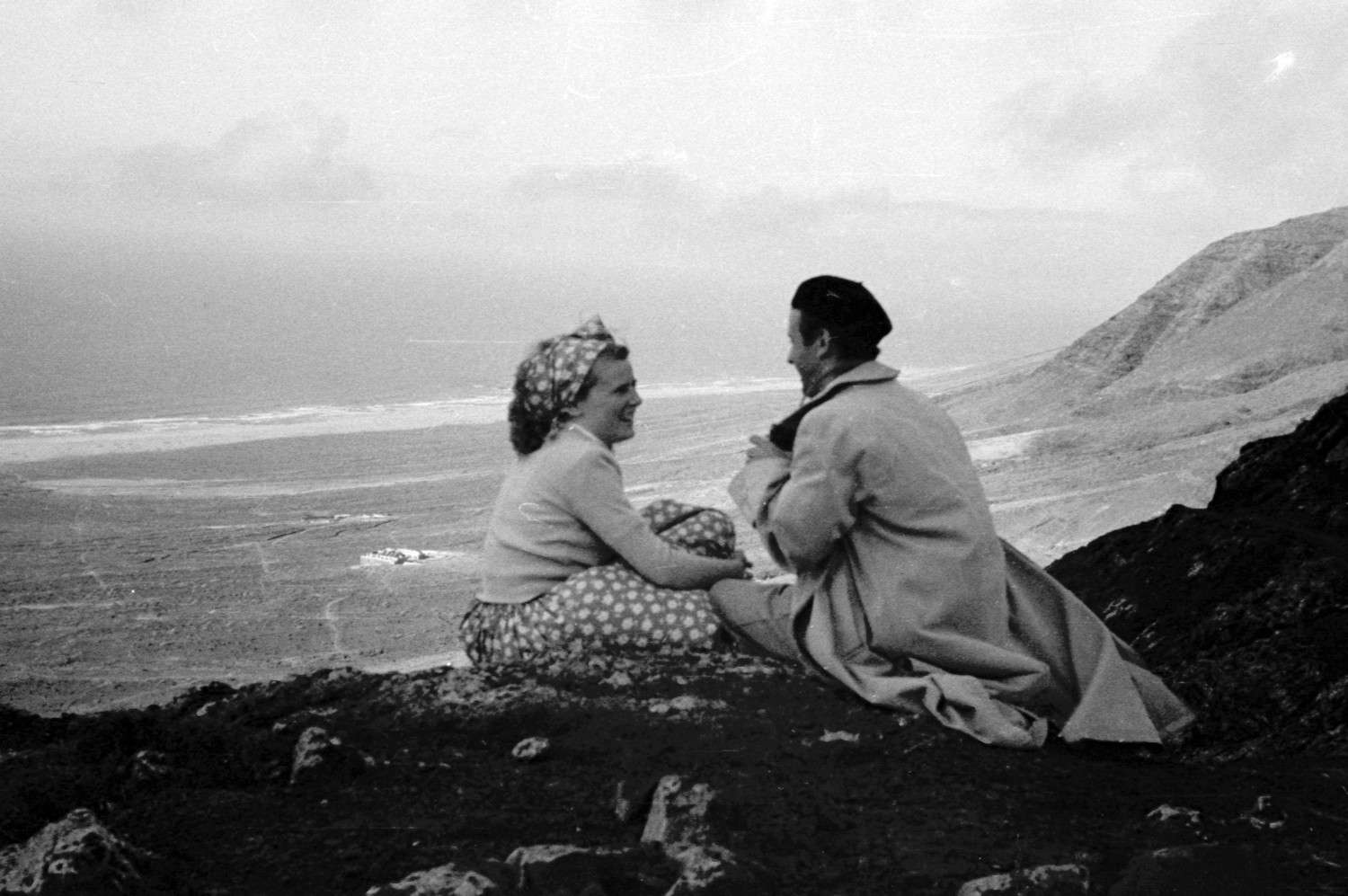 On this picture, we can see Johanna and Petre in the Degollada de Gran Valle, and in the background the house as it was back then. The first or main floor without the second storey floor, or the tower.
On this picture, we can see Johanna and Petre in the Degollada de Gran Valle, and in the background the house as it was back then. The first or main floor without the second storey floor, or the tower.
Therefore, in October 1947, the work being down on the house significantly decreased, since they were working on the house in Moro Jable and, once the idea of digging a tunnel on Gran Valle was ruled out, the work that had recently started on the access road to Cofete on the current stretch, sped up: from Morro Jable to Gran Valle – Jorós – Valle del Mosquito – Valle de las Pilas – Access to Cofete through Degollada de Agua Ovejas – Down toward Vega de Cofete and the town. It was completed in December 1948.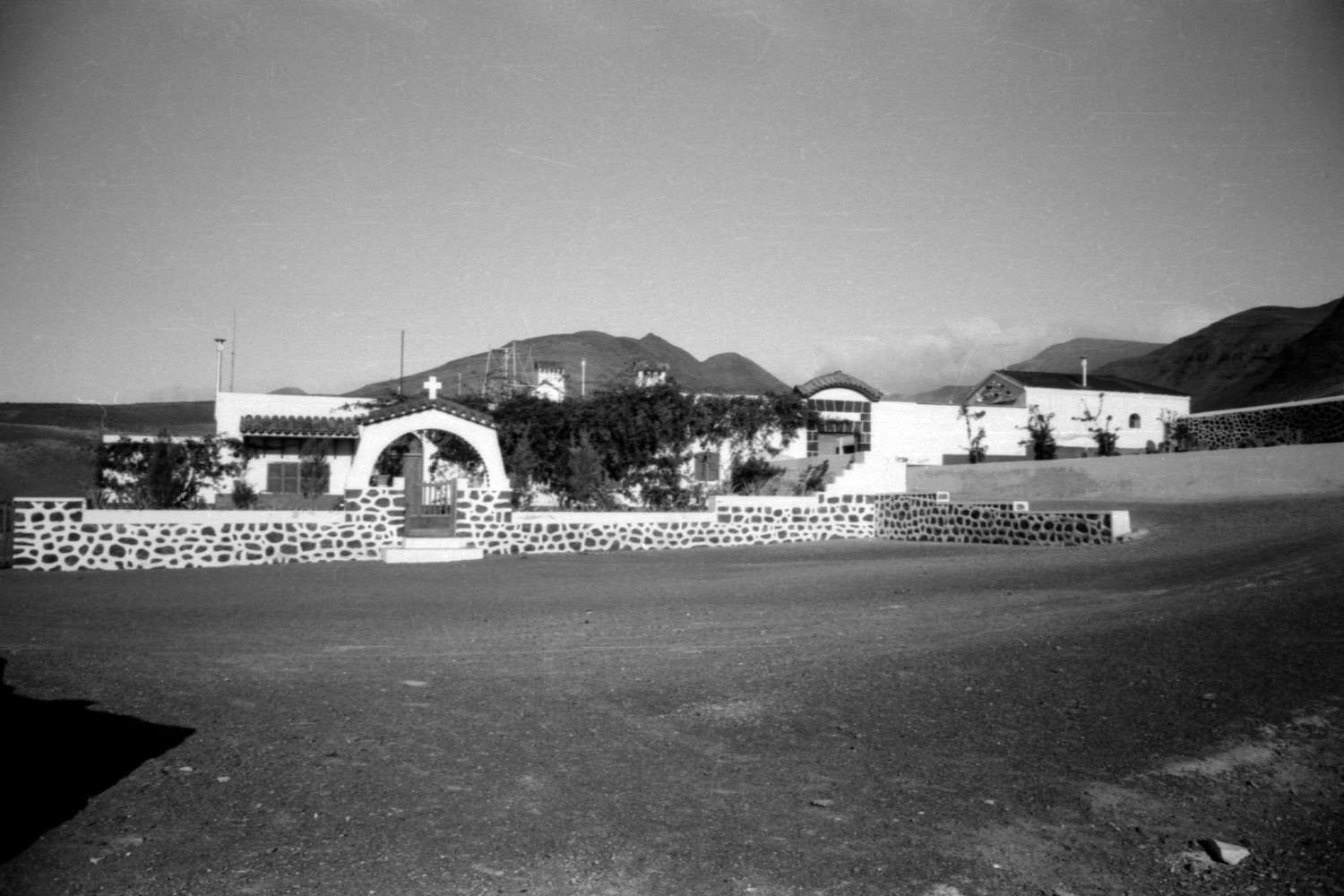 Handwritten note from IA on the back of this picture: (Das Tor zü ünserm “Paradies”. Sommer 1951)
Handwritten note from IA on the back of this picture: (Das Tor zü ünserm “Paradies”. Sommer 1951)
During that trip to the islands, Gustav Winter had an interview with Mr. Enrique Reitz, a German carpenter who had a workshop in Las Palmas de G. C. He went to Fuerteventura for a few days, they visited the house and he was commissioned to do the carpentry work. On 15/10/1947 him and Mr. Arturo Kamphoff, as representative of Dehesa de Jandía and Mr. Manuel Girona, signed the contract. Find also attached, two documents: one of them including the material that was being handed over (hinges, handles, locks, etc.) and another one specifying the measurements of wardrobes and the gaps for the doors and windows, numbered according to the contract, handwritten in pencil by Gustav Winter. The last one of the measurements corresponds to alcoves on the south facade, mentioned on drawing 2e.
Mr. Enrique did some carpentry work —as well as all the doors and windows, the Riga wooden floors, the wardrobes, the library, the dining room tables, etc.— and up until 1953 he used to often go from Gran Canaria to Cofete to put it all together.
During those weeks, Gustav Winter often walked through Degollada de Gran Valle to Cofete with Maestro Villalba, discussing and figuring out how to go about everything. Therefore, in the letters sent after he returned to Madrid, there’s no longer any drawings or technical instructions regarding the construction work, since everything had already been sorted out.
He also visited Mr. Salvador Falero, who lived in Casillas de Morales who, for a while, managed some of the agricultural work again, mainly in Esquinzo and Jorós, where there are water galleries.
When assessing letter nº 98, dated 20/11/1947, from AK a GS, we realise that the work on the house continued, since a letter from Gustav Winter to Maestro Villalba is mentioned —we don’t have that letter—, as well as two other letters for Mr. Salvador.
1948
We don’t have the letters written that year between Jandía (GS) and Madrid (GW). Although we do have the ones between Jandía (GS) and Las Palmas (AK).
1948 - Construction work of the house slowing down. The road became a priority
Once the structure of the work was done, and since it looked like IA had no intention of living in the house of Cofete in the future, the work went on, but with a much lower number of workers. Gustav Winter invested his money and effort in improving the connection and how to get potable water, so scarce in Jandía and such a key factor for agriculture. Maestro Villalba and some relatives (some of his children, as well as his brother Victorino and his son, Ramón) went on working in Cofete: on the house chalet, the water gallery and the road. The first work on the road was managed by his brother in law, Mr. Manuel Afonso, who soon returned to Gran Canaria, and Maestro Villalba took over then.
On letter number 73, dated 26/01/1948, from GS a AK, Mr. Guillermo reported that the work on the house “as such”, is finished, and that Maestro Mr. Juan Concepción Villalba would like to no longer be the building engineer (and wished to keep working only as a freelance builder). On a handwritten note from Gustav Winter, it says: “there is still a lot of work to be done in the House!”. So much so, as we can see, when reading the contract signed between Maestro Mr. Francisco Jorge Hernández in July 1952 (1952.4). On this letter, number 73, Mr. Guillermo mentions that if the Maestro is going to carry out the work on the gallery and the drain pipe, it would be advisable that the accident insurance would still be defrayed (the gallery “Mina de Cofete”, provides water to the house as well as to the tank and the house “Agua Camellos”).
1948 - Isabel Althaus and Gustav Winter move to Fuerteventura for good
On Thursday 19th August 1948, our parents left Madrid and headed toward the Canary Islands, where they lived until they died. “The group” leaving Madrid, consisted of IA, GW, their daughter Margarita and “aunt María” *. They boarded in Sevilla, in Ciudad de Alicante, and headed toward Puerto de la Luz in Gran Canaria.
(*) During their stay in Madrid, IA lived in the house of Mrs. María Valcarce and her sister Amelia in 1942 and 1943, with whom she became good friends. Mrs. María was in Jandía for a bit more than three years, and in January 1952, she returned to Vegarienza (León), where she was from.
Upon their arrival to Fuerteventura, on 7th September aboard the Viera y Clavijo, from Gran Canaria, right in Puerto Cabras, my parents were approached by Hamed (“Jamete”), who offered to work at the house. He joined the group and headed toward Morro Jable with them. Some time later, his wife and children joined them from the Sahara.
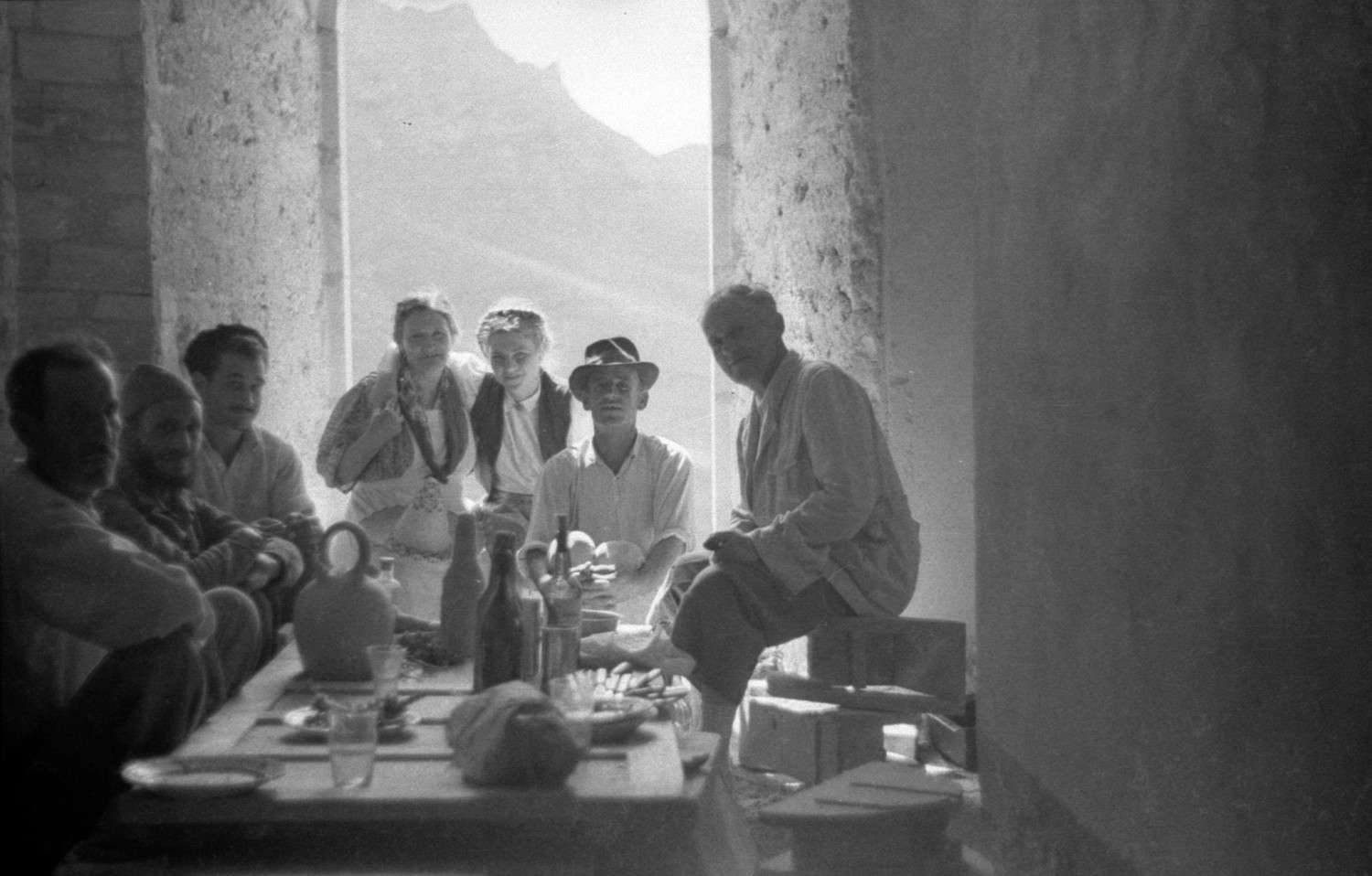 Taken by Margarita Winter. Having lunch in the basement of the house, next to the gap of the entrance, heading west, with the mountains in the background. From left to right: el Maestro Mr. Juan Concepción Villalba, “Jamete”, Mr. Juan Concepción Hernández —son of Maestro Villalba—, aunt María, Isabel Althaus, Mr. Patricio Francés —“in charge of the corrals”, who made some lamb for lunch— and Gustav Winter.
Taken by Margarita Winter. Having lunch in the basement of the house, next to the gap of the entrance, heading west, with the mountains in the background. From left to right: el Maestro Mr. Juan Concepción Villalba, “Jamete”, Mr. Juan Concepción Hernández —son of Maestro Villalba—, aunt María, Isabel Althaus, Mr. Patricio Francés —“in charge of the corrals”, who made some lamb for lunch— and Gustav Winter.
On letter number 9 from AK to GW —already in Jandía—, dated 20/10/1948, Mr. Arturo wrote that it was necessary for Maestro Villalba to resume the work, and to hire “the four producers” with employees again, as well as the Plus Ultra insurance and Social Security.
1949 – 1951
We still have the letters between AK (Gran Canaria) and GW (Jandía) going from September 1948 and December 1949. On those letters, Mr. Arturo answers some of the requests made from Morro Jable and also informs about the state of the accounts, the money transfers received from Barcelona (Manuel Girona), the payments made for work done (i.e. to carpenter Mr. Enrique Reitz) and the purchase and shipment of iron, concrete, bricks and wood for the house, the seeds for crops and vaccines for cattle and dogs. Other letters talk about the paperwork done with several institutions such as the Civil Government, the Cabildo and the Supplies Delegation, in order to get the vast amounts of potatoes, corn, rice, bananas, etc. according to the corresponding quota available for the population of Jandía, and then send them over.
Gustav Winter had recently arrived to Jandía. One of the main things he did was to bring the paperwork of the house to date. Architect Mr. Eduardo Laforet took care of the “reconstruction project of an agricultural house in the land of Cofete” “reconstruction project of an agricultural house in the land of Cofete” and a clarifying report with it (1949.1). Mr. Antonio Falcón submitted it at the Las Palmas association of building engineers of Las Palmas, mentioning that he will be in charge of the management and inspection work.
On letter number 98, from AK to GW, dated 06/06/1949, it says that he’s sending 3 samples of the House of Cofete reconstruction project and the licence application that has to be signed and then submitted to Pájara Town Hall. In addition, the liquidation made by Sr. Falcón is mentioned: the amount for the project, managing the work and the fees to pay to the association of building engineers. Yet again, the letter mentions the lack of concrete, since the quotas provided at the Construction Union have been suppressed due to the paralysation of cement factories. This document includes the work licence application to Pájara Town Hall, signed by GUstav Winter “as requested by Mr. Manuel Girona”, and its approval, dated 19/07/1949, signed by the Town Hall acting Secretary Mr. Pedro E. Soto Hernández. The project submitted doesn’t exactly coincide with the work being carried out.
The construction of the house progresses slowly. Gustav Winter has other prioritys
Work on the house progressed slowly. Gustav Winter was especially keen on improving communications all over the plot of land. It was now high time to take the road all the way to Punta de Jandía and other points such as Cueva de la Negra. It was there, where, in 1949, the wood needed for the ceilings was taken to (as mentioned in a letter dated August 1947), but there was a delay of almost two years until the road was built. The wood was then loaded onto the van and taken to the house.
He also made sure to improve farming and agricultural production. Paths were made leading to all downwind valleys, also ditches were built, and plots were turned over to plant in them. Karakul sheep were brought over from the mainland and other breeds from El Hierro. In 1949, advised by lawyer Mr. Rafael López Socas, a new Medianería Agreement was signed. Subsequently, the wire fence was built.
In 1950 and 1951, the work on the house continued. Although there are no documents regarding that work, we do have some photos.
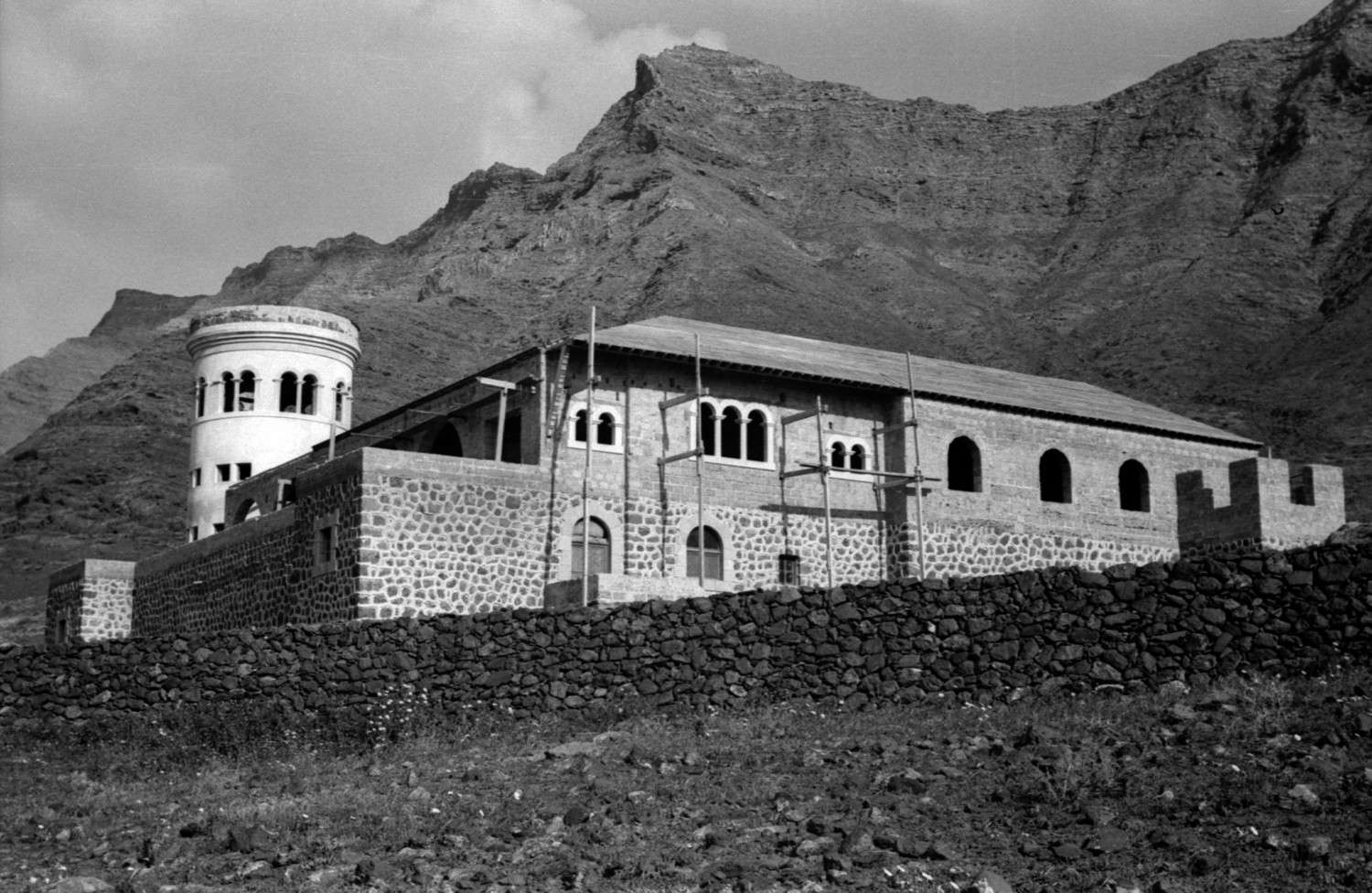
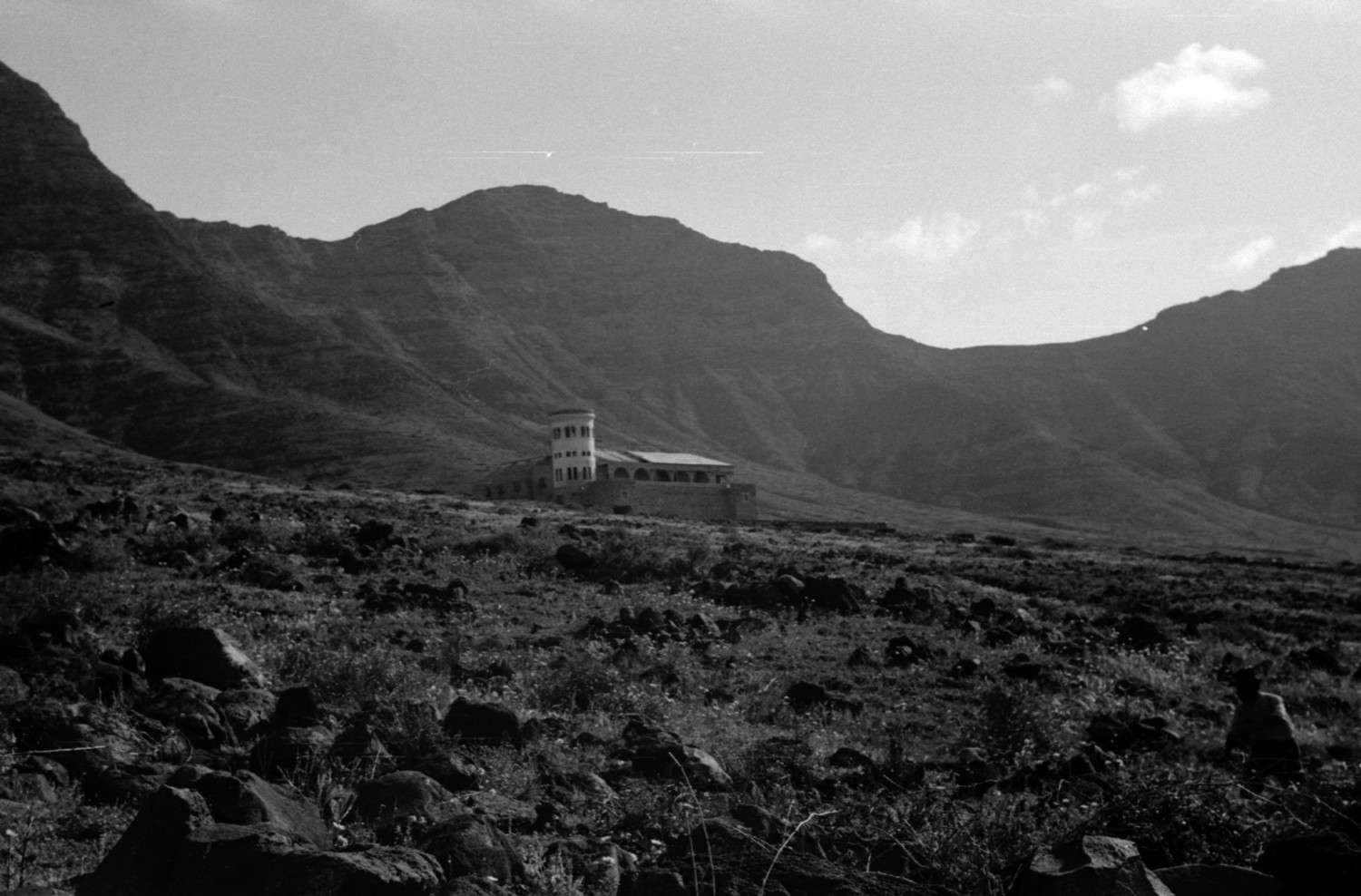
Many members of the Concepción family worked in Cofete in the late 1940’s and early 1950’s.
1952
Gustav Winter wanted to finish the house that year
That year, Gustav Winter resumed the many jobs still to be done to finish the house.
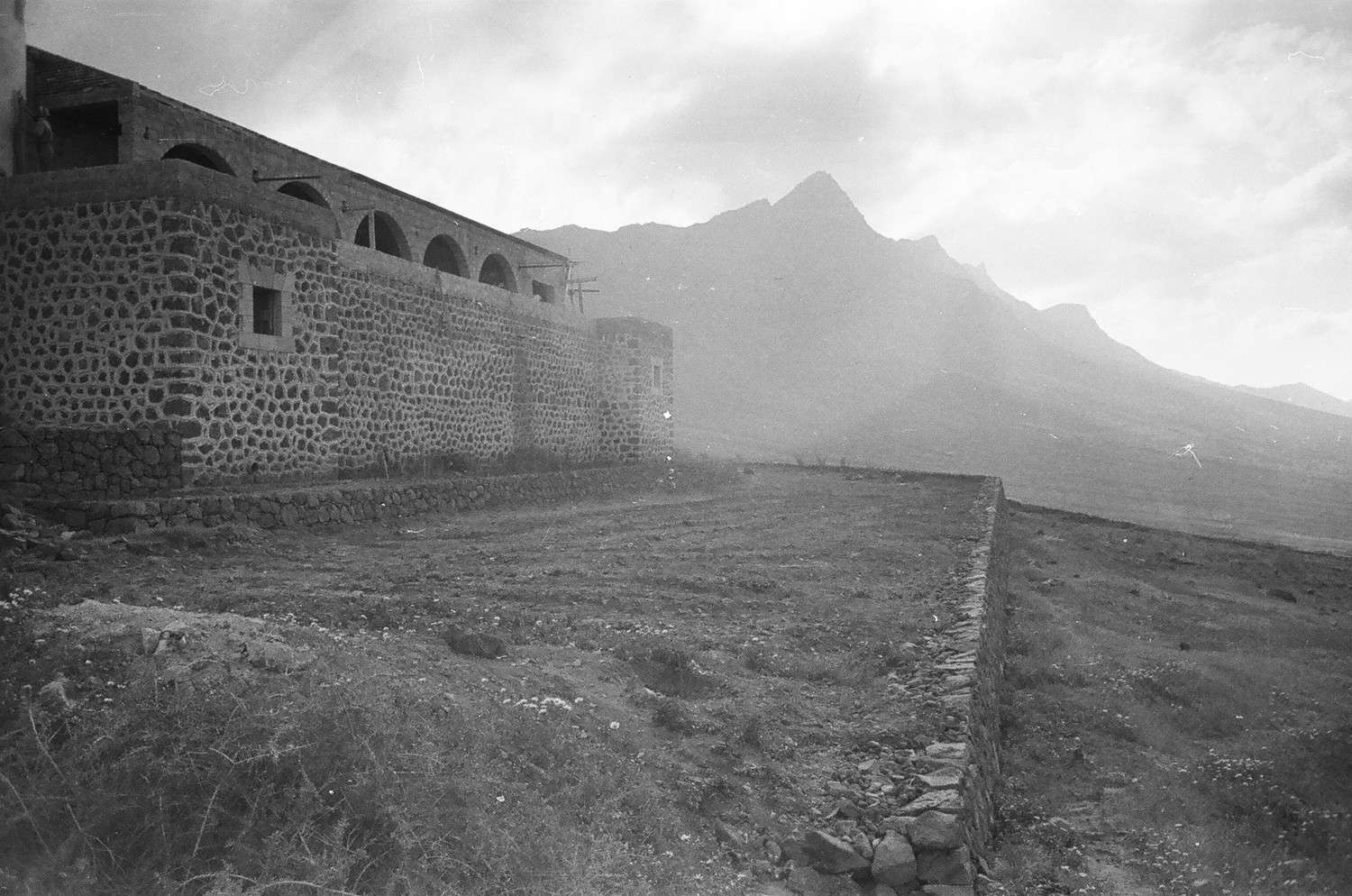 Stage the work was at in February 1952
Stage the work was at in February 1952
On Gustav Winter’s personal diary, on 5th May, it says that Maestro Victorino had an accident, it seemed to have been a serious one. Mr. Guillermo went of on the jeep to Puerto Cabras looking for a doctor. They got back to Morro Jable at 4 am, Dr. Peña and Dr. Juan Cabrera, and they went off to Cofete.
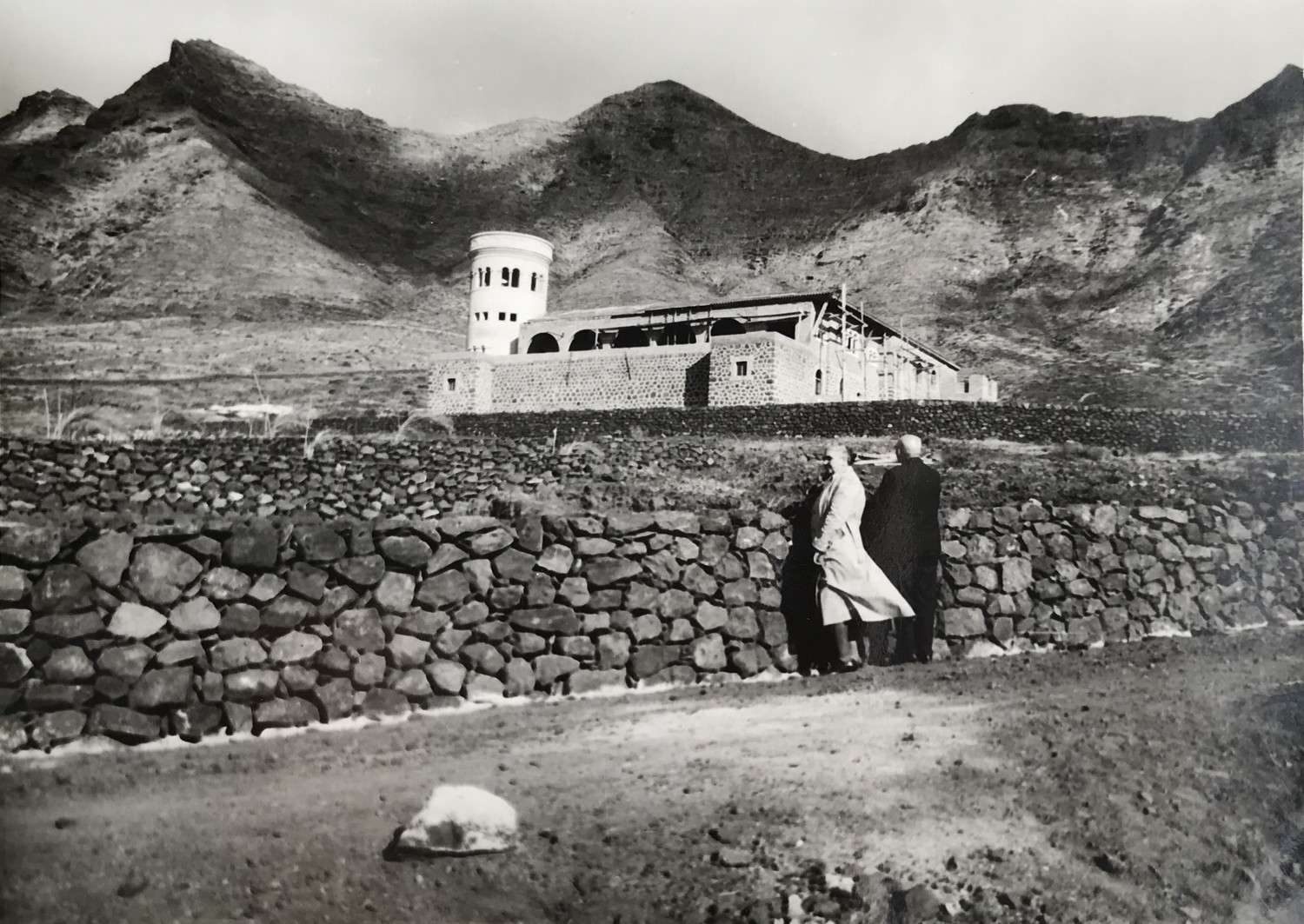 In May 1952, our grandparents, on our mother’s side, visited Fuerteventura for the first time, for the birth of the couple’s first child, Juan Miguel. Needless to say, they visited Cofete.
In May 1952, our grandparents, on our mother’s side, visited Fuerteventura for the first time, for the birth of the couple’s first child, Juan Miguel. Needless to say, they visited Cofete.Our parents went to Gran Canaria at the beginning of June, some weeks before the birth.
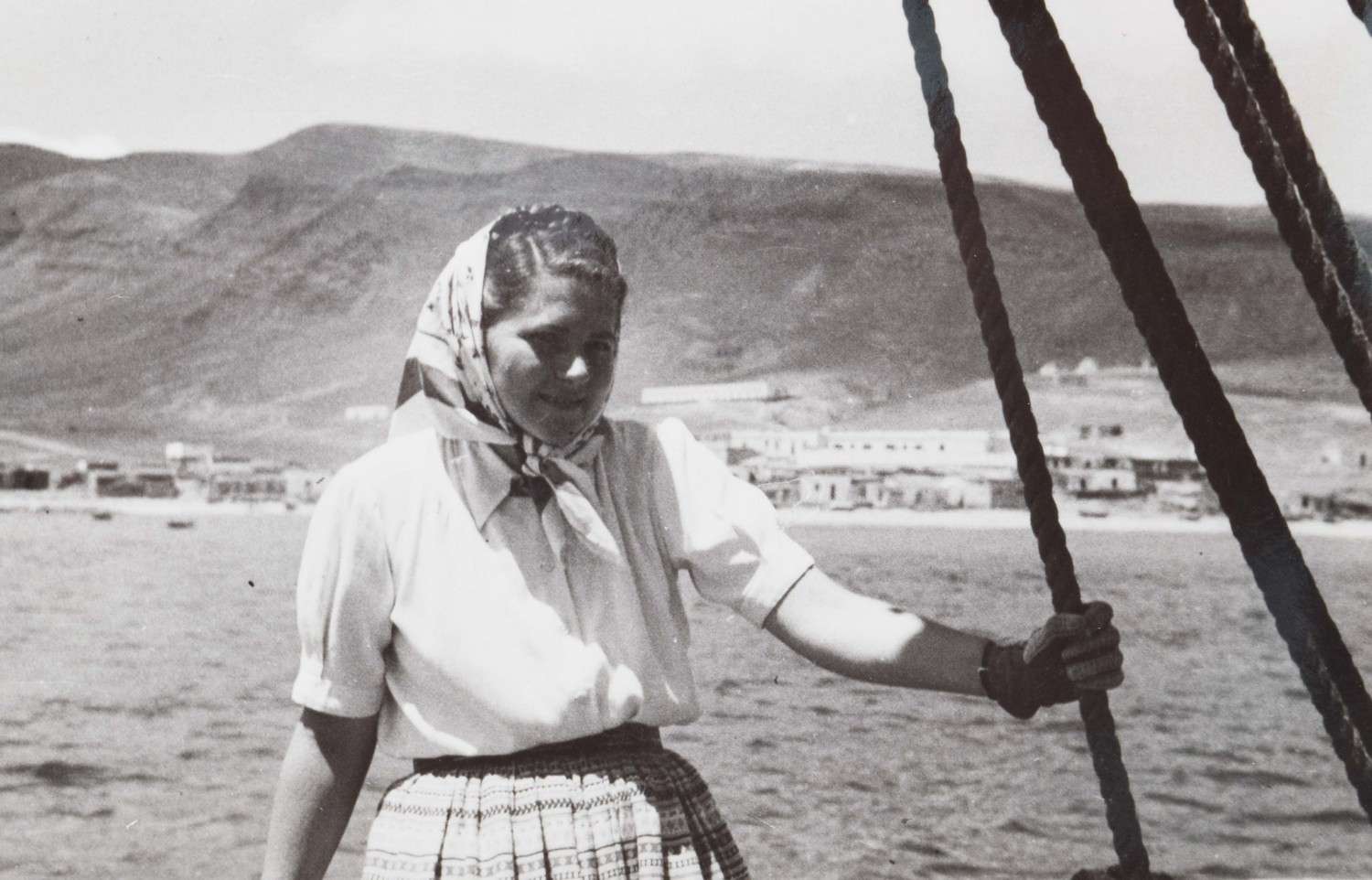 Isabel Althaus going from Morro Jable aboard the Guanchinerfe heading toward Gran Canaria, weeks before giving birth. (1952)
Isabel Althaus going from Morro Jable aboard the Guanchinerfe heading toward Gran Canaria, weeks before giving birth. (1952)
They were in Las Palmas for about a month (in Hotel Atlántico), Gustav Winter exchanged letters with D. Gregorio Soto —administrator in Morro Jable—. (1952.4) This document includes 4 letters: in the first one of them, Mr. Gregorio asks GUstav Winter to give the green light to the shipment of supplies aboard the Guanchinerfe corresponding to the quota available for the people of Jandía: Canarian cornmeal, corn, flour, sugar, oil and rice. At the end of the letter, he confirms the arrival of 103 sacks of concrete and joists aboard the. Two days later, he confirms that Maestro Victorino agrees with the quality of the concrete and the length of the beams. Furthermore, he informs about the fact that the Maestro needs more bricks and beams. In GUstav Winter’s answers, he mentions sending part of the “supplies” and on letter dated 02/07/1952, he mentions that there are two electricians on the way and a batch of bricks and Arabic curved tiles for the house. He also mentions that he shall be returning to Morro Jable on Friday 04/07/1952.
During his stay in Gran Canaria, on 02/07/1952, GUstav Winter signed un contract with Mr. Francisco Jorge Hernández, construction work Maestro, to head over to Cofete with several workers, and to manage the work for 3 months.
The work yet to be done is explained: “The structure is done, but there is still the Arabic tile roof to be done, the outdoor and indoor plaster, the ceilings, the floor tiles, doors and windows, bathrooms, the kitchen, and other installation work.”
They mention that “Nowadays, there are several maestros and workers from Lanzarote doing the work, but they always go back home to Lanzarote in mid July for a 2-3-month holiday period”.
“Having seen the urgency to complete the work on the house before the winter comes”, he decides to hire them to keep working during the holiday period.
On 09/07/1952, Maestro Francisco, 3 building officers and 2 workers arrived to Morro Jable.
Gustav Winter’s mind was back then clearly focused on finishing the work once and for all. In his personal diary that year, it says that he spent most of the last four months in Cofete, sleeping over from Monday to Friday, supervising the work. On a letter dated 25/09/1952, written to his friend Mr. Alfredo Suárez Ochoa, he says that in the house, there have been “a maestro, four building officers and four workers from Las Palmas for three months, as well as 30 other workers from Jandía”. Once the Concepción family returned after their holiday in Lanzarote, the others went back to Gran Canaria. There was also the carpenter and two electricians (Sr. Gebauer and Mr. Pedro López). All the “outside” staff (from Gran Canaria, Lanzarote or other parts of Fuerteventura) and many of the ones who were from Jandía, lived in the house, whilst working there. They stayed in the different rooms that were already roofed, and had two cooks making their food.
Among other work done on the house, there were doors, windows and glass being installed. In addition, the iron frame at the entrance. There were floors placed on several rooms, some using tiles, other using wood. There was work being done in bathrooms, putting down tiles and doing some plumbing too: taps and ¾ iron pipes. Also, the electrical tubes. Riga wood and caobillas was used. Some granite pieces to be used in the kitchen and bathrooms. There were beams and boards placed, as well as the curved Arabic tiles on the roof.
1953 - 1955
The work kept going throughout all of 1953
There are several notes on his personal diary that year, mentioning several jobs being done in the house. There are some references made regarding Mr. Enrique Reitz, who went from Gran Canaria to Cofete to do some carpentry work: wardrobes, bedrooms, dining room, library, shelves, door frames, light covers, balustrades, sets of stairs, decorative ornaments, etc.
The electrical work continued, led by Mr. Pedro López. The Concepción Family kept on working on the aforementioned jobs. Mr. Eliseo and “Martinito” Rodríguez also worked in Cofete.
We don’t have a diary for 1954, which is when it looks like the work in the house was completed.
The years that followed, some sporadic work was carried out by “Juan el Canario” and some workers. In 1955, the stable was built and there was work being done to the stone walls.

